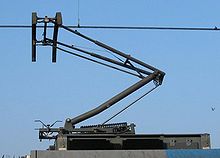pantograph
Jump to navigation
Jump to search
English[edit]



Alternative forms[edit]
Etymology[edit]
From French pantographe, from panto- (from Ancient Greek παντός (pantós), genitive singular of πᾶν (pân, “all”)), and -graphe (from γράφειν (gráphein, “to write”)).
Pronunciation[edit]
Noun[edit]
pantograph (plural pantographs)
- A mechanical linkage based on parallelograms causing two objects to move in parallel; notably as a drawing aid.
- A pantograph can be adjusted to make either scaled or exact copies.
- Synonyms: lazy tongs, omnigraph
- By extension, a structure of crosswise bars linked in such a way that it can extend and compress like an accordion, such as in a pantograph mirror or a scissor lift.
- A pattern printed on a document to reduce the ease of photocopying.
- I was impressed by the quality of the pantograph; I hadn't noticed it on the original, but the copies were covered in unpleasant lines.
- (rail transport) A similarly-formed conductive device, now usually Z-shaped, that collects electric current from overhead lines for trains and trams.
Derived terms[edit]
Related terms[edit]
Translations[edit]
mechanical drawing aid
|
pattern to hamper photocopying
rail transport: device that collects electric current from overhead lines
|
- The translations below need to be checked and inserted above into the appropriate translation tables. See instructions at Wiktionary:Entry layout § Translations.
Translations to be checked
|

Verb[edit]
pantograph (third-person singular simple present pantographs, present participle pantographing, simple past and past participle pantographed)
- To engrave by means of a pantograph (parallel linkage) system.
Further reading[edit]
 pantograph on Wikipedia.Wikipedia
pantograph on Wikipedia.Wikipedia  Pantograph (rail) on Wikipedia.Wikipedia
Pantograph (rail) on Wikipedia.Wikipedia  Category:Pantographs on Wikimedia Commons.Wikimedia Commons
Category:Pantographs on Wikimedia Commons.Wikimedia Commons - https://web.archive.org/web/20071030212926/http://glossary.ippaper.com/default.asp?req=knowledge%2Farticle%2F243